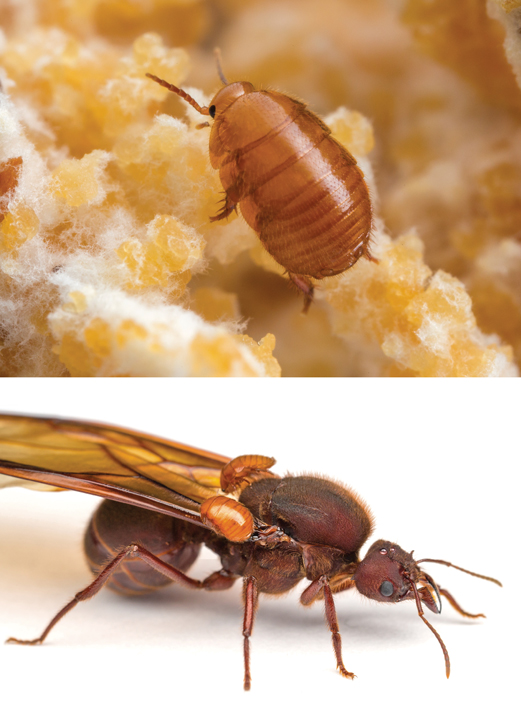
This Article From Issue
March-April 2023
Volume 111, Number 2
Page 120
THE GUESTS OF ANTS: How Myrmecophiles Interact with Their Hosts. Bert Hölldobler and Christina L. Kwapich. xvi + 559 pp. Belknap Press of Harvard University Press, 2022. $69.95.
Studies of ants typically emphasize behavior and the evolution of sociality because they intrigue us as a different kind of society that helps us better understand our own. But there is a second reason to study ants, a second parallel with the human condition, and that involves the intimate associations ants have with many other species.
We increasingly recognize that humans are walking ecosystems, hosting innumerable microorganisms that range from pathogens to beneficial elements of the microbiome. Ant colonies are diverse ecosystems as well. Ant societies attract a remarkable diversity of housemates, known as myrmecophiles, that are intimately associated with and dependent on their hosts. These myrmecophiles come from nearly every type of terrestrial life, including microbes, fungi, nematodes, mites, silverfish, crickets, beetles, butterflies, parasitic wasps, and snakes. In some cases, myrmecophiles are beneficial to the ants, but more often they are freeloaders, thieves, murderers, or grifters of all manner.

Courtesy of Alex Wild / alexanderwild.com
A book synthesizing the biology of myrmecophiles is long overdue, and now we have it. In The Guests of Ants, Bert Hölldobler and Christina Kwapich introduce us to this amazing menagerie, synthesize centuries of observations, and bring us up to speed on the latest science. The book is technical and densely packed with information, clocking in at 559 pages, and has the potential to be a long-lasting benchmark and resource for the specialist. But it is also a pleasure for any curious naturalist, flipping through the pages to land on images of remarkable creatures with remarkable stories. On one page, a new leafcutter ant queen, about to take flight, has two miniature cockroaches perched on her back; we learn that these tiny roaches, Attaphila fungicola, are myrmecophiles that hop a flight with a new queen to disperse to new colonies. On another page, workers of the ferocious weaver ant (Oecophylla) investigate what looks like a nicely browned loaf of bread in their nest, but which is, in fact, the pupa of a butterfly (Liphyra), whose larvae grow up feasting on ant larvae and whose skin has special structural modifications that protect it from ant bites.
The epilogue is worth reading first. In addition to concluding statements, it also explains why such a diversity of organisms has specialized in living with ants. First, the ant nest represents “an ecological island lavishly endowed with nutrients,” and is thus a target for colonization. Second, ant colonies are “porous to invasion” because ants are social. Ants have evolved in various ways to recognize nestmates, often using a kind of chemical code. As with human interactions, these secret codes are vulnerable to being cracked by outsiders, and myrmecophiles have insinuated themselves into ant life by mimicking the diverse forms of communication that ants use.
The first chapter of the book is a primer of ant biology, followed by nine chapters about particular groups of myrmecophiles or common adaptations. Each of the chapters could be a stand-alone review, but together they provide a complete picture of the ant ecosystem. One chapter covers the lycaenid butterflies that have close associations with ants, either as mutualists or predators. Another chapter is all about mimicry of ant workers, especially by spiders.
Two generations of Hölldoblers have been studying myrmecophiles. The work of both Bert Hölldobler and his father Karl is thoroughly reviewed, revealing the elaborate behavioral and morphological specializations of myrmecophilous beetles. The biology of the aptly named ant-loving cricket gets its own chapter, highlighting Kwapich’s work on the mystery of size-matching between these cricket guests and their ant hosts. The final chapter summarizes vertebrate associates of ants, from blind snakes to the anting behavior of some birds. There is a glossary and a full 44 pages of references, and the entire book is copiously illustrated with photos or artful depictions of ants and their associates.
The natural history of myrmecophiles is a knowledge base that builds upon itself. Erich Wasmann was a late 19th-century and early 20th-century entomologist who used studies of myrmecophiles to inform debates on evolution and the role of natural selection. Although his evolutionary theorizing is rarely cited today, he also made careful and detailed observations of the natural history of myrmecophiles. It is satisfying to see Wasmann references from the 1890s in this book, cited not as historical footnotes, but as sources of knowledge no less relevant than a 2022 reference. I also appreciated the attention paid to taxonomic changes. Many studies of myrmecophile biology were developed using a taxonomy that was static for decades or centuries. It was a taxonomy that had no problem putting highly derived specialists such as significantly modified myrmecophiles in separate genera or families at equal rank to their unspecialized relatives, from which they arose. The phylogenetics revolution that began in the 1950s and continues to the present day has resulted in an extended period of nomenclatural instability, due to both revised ideas of phylogeny and a desire for nomenclature to reflect phylogeny. Hölldobler and Kwapich take pains to explain very recent nomenclatural changes to taxa with long histories of investigation under older names.
In addition to being a broad survey of descriptive natural history, there is also a strong hypothesis-testing framework in the book. Often studies are summarized, and then critically evaluated. Instead of just “This study did X and found A and B,” it is often “This study did X and found A and B, but support for B is not strong, and C is also a possibility, and it would be interesting to do Y to test whether B or C is more likely.” Thus, the book is not merely a dry compendium of facts, but rather, it is full of opportunities for critical thinking.
E. O. Wilson famously quipped that ants are “the little things that run the world.” The Guests of Ants reveals that they not only run the world, they are the world for thousands of other species that have evolved to depend on them. Although biodiversity conservation is not emphasized in the book, the implications are clear: Conserving ant diversity protects far more than the ants themselves.

American Scientist Comments and Discussion
To discuss our articles or comment on them, please share them and tag American Scientist on social media platforms. Here are links to our profiles on Twitter, Facebook, and LinkedIn.
If we re-share your post, we will moderate comments/discussion following our comments policy.